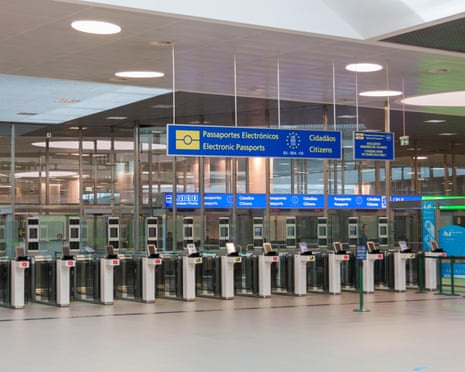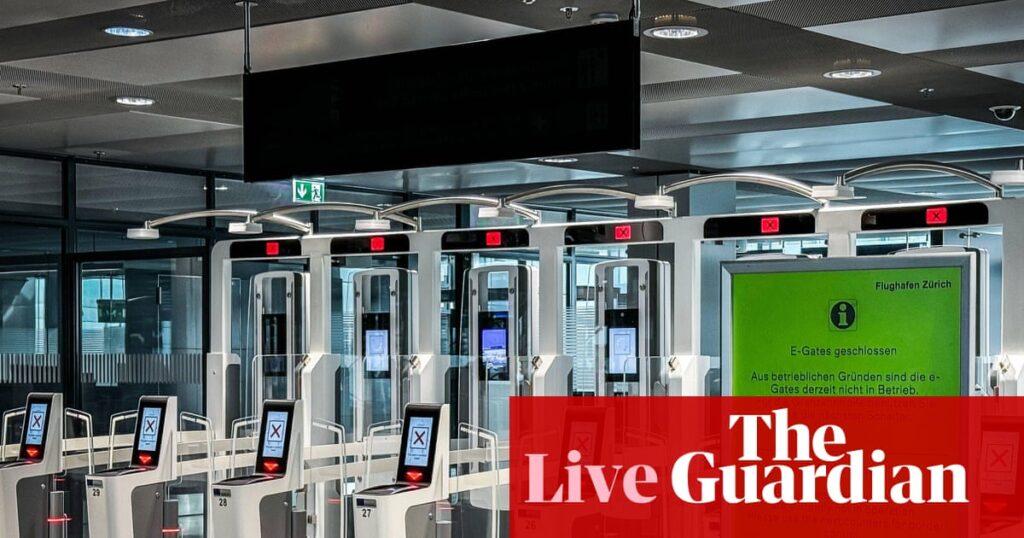EU to start rolling out its biometrics entry system for non-EU visitors from October
Lisa O’Carroll
in Brussels
The EU has announced it will launch the rollout of its new entry system involving fingerprinting and facial recognition instead of passport wet stamping on 12 October.

Photograph: David Gee 4/Alamy
The EU entry exit system (EES) system is being introduced ahead of the midterm break on schools and will impact any tourists or business travellers who are not EU citizens, including Britons.
“From 12 October onwards, member states will start introducing the EES gradually over a period of six months. Border authorities will progressively register the data of third country nationals crossing the borders. At the end of this period, the EES will be fully deployed at all border crossing points,” the EU said in a statement.
The plan to capture biometrics is part of the EU’s wider “smart border” programme which will allow the EU to speed up the entry of pre-approved frequent non-EU travellers while at the same time fighting against irregular migration.
Fingerprinting machines are already visible at the Eurostar terminal in London with kiosks being built for car, bus and truck passengers in Dover.
Passengers will be required to have their fingerprints or facial image verified but not both after passing through a border for the first time.
Once up and running fully it will be British tourists and other non-EU visitors will no longer have their passports stamped.
It will also enable the EU to see, at a glance, whether the passenger is overstaying.
“The is an advanced technological system that will digitally record the entries and exits of non-EU nationals travelling to 29 European countries, including Schengen Associated ones, for short stays. It will capture biometric data, such as fingerprints, facial image, and other travel information, gradually replacing the current system of passport stamping,” the European Commission said.
Road transport operators including the Port of Dover and Eurotunnel had hoped an app would be ready for the launch of the EES, but it has been delayed as each member state works to integrate it into their own immigration system, which are of national, rather than EU, competency.
The rollout will take place over six months.
Key events
Russia claims it is ‘immune’ to sanctions, dismissing Trump’s threat
Back to Ukraine, Russia has claimed it developed some immunity to sanctions because it had lived under a huge number of them for a long time, Reuters reported.
The latest response from the Kremlin comes as Russia continues to assess the recent declaration by US president Donald Trump signalling a 10-day deadline for reaching a ceasefire in Ukraine under the threat of economic sanctions against Moscow.
EU to start rolling out its biometrics entry system for non-EU visitors from October

Lisa O’Carroll
in Brussels
The EU has announced it will launch the rollout of its new entry system involving fingerprinting and facial recognition instead of passport wet stamping on 12 October.
Photograph: David Gee 4/Alamy
The EU entry exit system (EES) system is being introduced ahead of the midterm break on schools and will impact any tourists or business travellers who are not EU citizens, including Britons.
“From 12 October onwards, member states will start introducing the EES gradually over a period of six months. Border authorities will progressively register the data of third country nationals crossing the borders. At the end of this period, the EES will be fully deployed at all border crossing points,” the EU said in a statement.
The plan to capture biometrics is part of the EU’s wider “smart border” programme which will allow the EU to speed up the entry of pre-approved frequent non-EU travellers while at the same time fighting against irregular migration.
Fingerprinting machines are already visible at the Eurostar terminal in London with kiosks being built for car, bus and truck passengers in Dover.
Passengers will be required to have their fingerprints or facial image verified but not both after passing through a border for the first time.
Once up and running fully it will be British tourists and other non-EU visitors will no longer have their passports stamped.
It will also enable the EU to see, at a glance, whether the passenger is overstaying.
“The is an advanced technological system that will digitally record the entries and exits of non-EU nationals travelling to 29 European countries, including Schengen Associated ones, for short stays. It will capture biometric data, such as fingerprints, facial image, and other travel information, gradually replacing the current system of passport stamping,” the European Commission said.
Road transport operators including the Port of Dover and Eurotunnel had hoped an app would be ready for the launch of the EES, but it has been delayed as each member state works to integrate it into their own immigration system, which are of national, rather than EU, competency.
The rollout will take place over six months.
Italy summons Russian ambassador over inclusion of president, ministers on list with ‘examples of Russophobia’
The Italian foreign ministry has summoned the Russian ambassador to Rome, Alexei Paramonov, after comments by the country’s president, foreign and defence ministers were listed on the Russian government’s website as “examples of Russophobia.”
The lengthy list, published last week, includes quotes from politicians from Bulgaria, Belgium, Canada, Croatia, the Czech Republic, Cyprus, the EU, France, Germany, Greece, Nato, the Netherlands, Luxembourg, Poland, and the US.
For Italy, the list includes the country’s president Sergio Mattarella, foreign minister Antonio Tajani and defence minister Guido Crosetto.
In a much-covered speech in Marseille (Europe Live on 6 February), Mattarella made a reference comparing the sentiments behind the Russian invasion of Ukraine to the rise of Nazi Germany.
The Italian foreign ministry’s press release said that Tajani “considered the inclusion of the head of state on this list a provocation to the Republic and the Italian people.”
EU hold talks with US on ‘finessing’ trade deal, implementing it legally

Lisa O’Carroll
in Brussels
The European Commission held phone calls with officials in Washington yesterday with intense work under way to finesse the precise list of goods on the zero-for-zero tariff list.
This is expected to be completed before a joint statement is made giving the detail to the headlines agreed at Donald Trump’s golf course on Sunday.
The US is expected to implement its part of the deal by executive orders by Donald Trump before Friday with the EU still determining what legal instrument it will use to give legal effect to the deal, a move that is unlikely to happen this week.
The EU will seek to copper-fasten the deal legally to guard against any attempts at changes by the US.
Yesterday Howard Lutnick gave the impression that it may yet seek guarantees from the EU that there is no tech tax.
The EU declined to comment on his remarks on CNBC in which he described the deal as “sensational” but insisted it retained the sovereign right to legislation however it saw fit.
It is not clear what the timeline on giving the deal legal effect on the EU side is but nothing is expected before Friday.
Tariff changes on the EU side involving an elimination of import duties are not as transformative to the trade relations with the US, said EU officials as more than 90% of goods the US sells into the EU attract either a zero tariff, or what an official described as a “nuisance tariff” or negligible tariff.
Emergency services battling wildfires in Spain and Portugal
Elsewhere, I am also keeping an eye on wildfires in Spain and Portugal as southern Europe continues to experience extreme temperatures this summer.
Two wildfires broke out earlier this week in Cuevas del Valle in Castilla y León and in Las Hurdes in Extremadura regions of Spain, with firefighters still battling them on Wednesday morning with some residents having to evacuate their homes.
The latest dramatic footage shared by the local authorities showed the contuining blaze captured from drones.
Over in Portugal, while fires remain active in three areas if the country, they are reportedly closer to being under control. In Ponte de Lima, there is a six-kilometer active front, Diario de Noticias reported, with firefighters suffering from shortage of resources to fight the fire.
Some parts of the country are set to be hit by another day of 40 degree heat today, with medium and high fire alert in multiple regions and most concern in the north of the country.
The EU’s Copernicus programme captured the impact of the wildfires in Arouca and Ponte de Barca in a satellite picture posted on its Instagram page.
France builds coalition of countries pushing for recognition of Palestinian state
One other topic to watch is the European reaction to France and the UK’s calls to recognise a Palestinian state.
On Tuesday night, the foreign ministers of 15 countries issued a joint statement backing such move.
France’s foreign minister Jean-Noël Barrot said on X that the group “invite those who have not yet done so to join us,” with AFP noting that Paris is trying to “build a momentum around the formal recognition of a Palestinian state.”
The group of 15 countries also include Andorra, Finland, Iceland, Ireland, Luxembourg, Malta, Norway, Portugal, San Marino, Slovenia and Spain, as well as countries outside Europe such as Australia, Canada and New Zealand.
German, Italian economies shrink 0.1% in second quarter
Elsewhere, we are getting the latest economic figures from Germany and Italy with both reporting -0.1% GDP growth in the second quarter.
Our business blog has more on the figures and their significance for the rate of growth in the eurozone.
Morning opening: D-9 for Trump, Russia and Ukraine

Jakub Krupa
“The Russians want to continue the war. This war can only be stopped through force,” Andriy Yermak, the most senior aide to Ukraine’s president Volodymyr Zelenskyy, warned this morning after another night of Russian attacks.
A missile strike on a Ukrainian training unit killed three and injured 18, following a pattern of similar attacks on Ukrainian training centres in recent months.
US president Donald Trump said last night he would give Russia ten days to cease fire – so that’s until 8 August – or face crippling economic sanctions.
On his way back to the US from Scotland, he said the clock was ticking with 10 days to go. And since that was technically yesterday, we’re on D-9 today.
The key question is what Trump will actually do when the clock runs down to zero, and this is exactly what Yermak’s comments this morning are about. Expect more of that language from various European leaders, joining Ukraine in the effort to push Trump into taking meaningful actions.
Elsewhere, we are obviously following the tsunami warnings issued across the Pacific region after a major 8.8 magnitude earthquake in far east of Russia with all live updates here …
… but on Europe live we will be looking also at the French government’s consultations with industries affected by the new EU-US deal, the wildfires in Portugal, and much more.
I will bring you all key updates from across Europe here.
It’s Wednesday, 30 July 2025, it’s Jakub Krupa here, and this is Europe Live.
Good morning.

